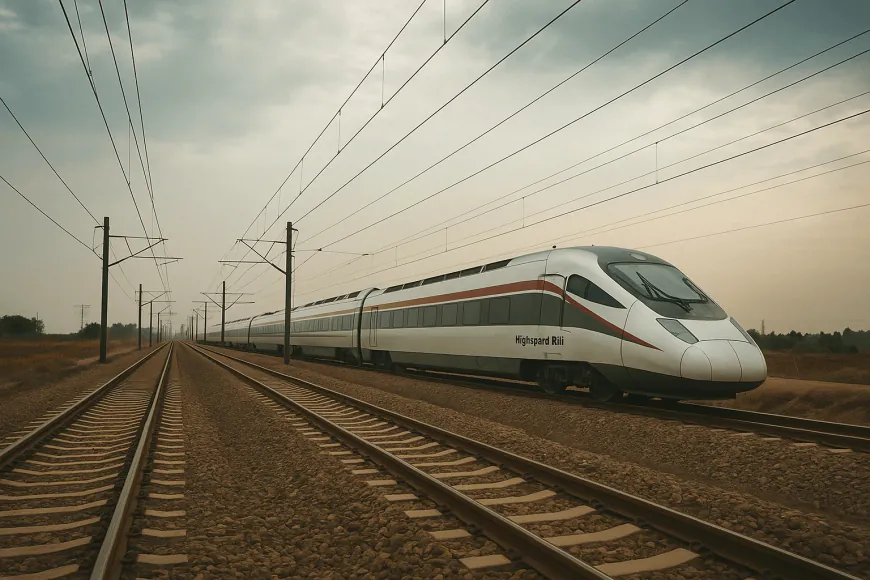Morocco Awards 1.4 Billion Dirham Contract for Rabat High-Speed Rail Tunnel: Critical Link in Kénitra-Marrakech LGV Network
SGTM-Sinohydro consortium secures contract for 3,300-meter high-speed rail tunnel under Rabat, connecting Bouregreg valley to Rabat-Agdal station. Key component of Morocco's 450km Kénitra-Marrakech LGV line.

In a significant development for Morocco's expanding high-speed rail network, officials have announced the award of a crucial contract for constructing a tunnel beneath the capital city of Rabat. This milestone marks an important step forward in the ambitious Kénitra-Marrakech high-speed rail line project, which aims to revolutionize transportation connectivity across the country's most populous corridor.
SGTM-Sinohydro Consortium Secures 1.4 MMDH Contract
Following a competitive bidding process, the contract has been awarded to a consortium comprising SGTM, a leading Moroccan construction firm, and Sinohydro Bureau 5, the prominent Chinese infrastructure developer. Their joint proposal, valued at 1.4 billion Moroccan dirhams (approximately $140 million USD), was selected as the most economically advantageous offer among all submissions.
"This contract represents a perfect blend of international expertise and local knowledge," commented an infrastructure analyst familiar with the project. "The SGTM-Sinohydro partnership brings together complementary strengths in railway infrastructure development and complex tunneling operations."
Industry observers note that this contract award reflects Morocco's strategic approach to developing world-class transportation infrastructure through carefully selected international partnerships while maintaining strong domestic involvement.
Comprehensive Tunnel Project Specifications
The underground passageway will span a total of 3,300 meters beneath Rabat's urban landscape, serving as a critical link connecting the Bouregreg valley to the modernized Rabat-Agdal station. This infrastructure project represents one of the most technically challenging components of Morocco's expanding high-speed rail network.
Detailed Section Breakdown
The tunnel project comprises three distinct structural segments designed to address varying geological conditions and operational requirements:
- Main Tunnel Section (2,750 meters): A single-block double-track tunnel forming the primary underground passage beneath the city center
- Open Surface Section (50 meters): A short uncovered portion facilitating the transition between above and below-ground segments
- Covered Trench Section (500 meters): A four-track covered trench designed to integrate new high-speed lines with existing conventional rail infrastructure
"The varying structural approaches reflect the complex urban environment through which this railway must pass," explained a transportation engineering expert. "Each section has been meticulously designed to minimize disruption while ensuring optimal operational performance."
Strategic Tunnel Positioning
The northeastern terminus of the tunnel will be situated at PK 235+450, strategically positioned near the Bouregreg valley and the existing conventional rail line. This location was selected to facilitate smooth integration with both natural topography and current transportation infrastructure.
At the southwestern end, the tunnel will emerge at PR 238+200 near the Jardin d'essai botanical garden, where it transitions through the open section mentioned above. This area has been carefully chosen to minimize visual impact on the surrounding cultural landscape.
Particularly noteworthy is the four-track covered trench section, which serves the critical function of harmoniously integrating the new high-speed tracks with existing conventional rail lines as they approach the renovated Rabat-Agdal station forecourt. This engineering solution addresses the complex spatial requirements of merging different rail systems within a constrained urban environment.
Construction Timeline and Technical Challenges
The construction timeline for this ambitious project has been set at 42 months, reflecting the complexity of tunneling beneath a densely populated capital city while maintaining uninterrupted transportation services. Work is expected to commence immediately following contract finalization.
The project faces several technical challenges, including:
- Minimizing vibration impacts on historic structures above the tunnel route
- Managing groundwater conditions in proximity to the Bouregreg river
- Ensuring continuous operation of existing railway services during construction
- Addressing complex geological formations beneath the city
"Tunnel construction in urban environments always presents unique challenges," noted a civil engineering specialist. "The contractors will need to implement sophisticated monitoring systems and construction techniques to ensure both project success and public safety."
Integral Component of Morocco's Visionary Rail Strategy
This tunnel project represents just one component—albeit a crucial one—of Morocco's comprehensive plan to extend high-speed rail service along the country's Atlantic corridor. The completed Kénitra-Marrakech line will operate at speeds up to 320 km/h, though the infrastructure is being designed to accommodate theoretical speeds of 350 km/h to future-proof the investment.
Spanning approximately 450 kilometers when complete, the high-speed route will connect several of Morocco's most important urban centers, including Rabat, Salé, Casablanca, and Marrakech. This transformative infrastructure project will dramatically reduce travel times between these economic and cultural hubs while significantly enhancing passenger capacity.
"This project exemplifies Morocco's forward-thinking approach to transportation infrastructure," remarked an economic development analyst. "By investing in high-speed rail, the country is positioning itself as a continental leader in sustainable mobility while creating the foundation for future economic growth."
The Rabat tunnel contract announcement comes amid growing international recognition of Morocco's infrastructure development program, which has been characterized by strategic vision, careful planning, and successful execution of complex engineering projects.
Broader Economic and Social Impact
Beyond the immediate transportation benefits, the high-speed rail expansion is expected to generate substantial economic and social dividends for Morocco. These include:
- Enhanced business connectivity between major commercial centers
- Increased tourism accessibility across the country
- Reduced carbon emissions through modal shift from road to rail transport
- Creation of thousands of direct and indirect jobs throughout the construction phase
- Development of domestic technical expertise in advanced railway engineering
As construction begins on this critical infrastructure component, attention will now turn to subsequent phases of the broader high-speed network development. Officials have indicated that additional contract awards for other segments of the Kénitra-Marrakech line are anticipated in the coming months.
The successful completion of this tunnel will mark another significant milestone in Morocco's remarkable transformation of its transportation infrastructure, further cementing its position as a regional leader in sustainable mobility solutions and infrastructure development excellence.


 TrainsNews
TrainsNews 





